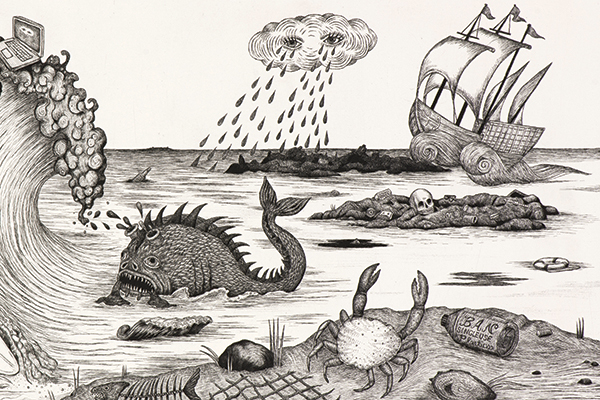Jenny Schmid - Momento Mare
- September 3–October 11, 2019
- Reception Thursday, September 26 at 6 pm
- Artist talk at 6:30 pm
- View the catalog

Artist Statement 2019
My work explores ideas of gender, identity and liberty and is inspired by the graphic tradition of social commentary. I draw from medieval engraving, Persian miniatures, current politics, and graphic novels to create a contemporary narrative. My work uses humor[MK1] to draw the viewer in and then asks them to confront greater social issues. Although I work in a range of graphic media, from lithography to animation, I return to black and white etching as the most direct (albeit laborious) method to emphasize the influence of historical sources and the urgency of my content.
My most recent prints take a new turn to connect with environmental themes through the use of mythical figures who confront the realities of encroaching technology and diminishing wilderness while continuing the search for utopian ideals and indulging in desire as a form of resistance. I am inspired by the history of fantastical beasts in printed imagery from the 1500s and 1600s such as The History of Four Footed Beasts and Serpents (Edward Topsell, 1658) as well as maps charting the sea, populated by various serpents, mermaids, mermen and sea monsters. I regularly visit archives to view original works and am attracted to how such encyclopedias freely conflate the real and the imagined, presenting chimera as if they have been witnessed by the engraver. Based on their ubiquitous presence, one almost starts to believe that sea monsters are real.
Although the yeti and the unicorn may seem to be icons of popular culture, these creatures are invented out of a need to simultaneously propagate an ideal and escape from confining social expectations. For example, in Medieval Northern Europe, The Wild People were mythical human-beast hybrids, free of societal constraints and morality. They lived in wild places, had sex without guilt and provided an attractive alternative to the confines of daily life and morality. They were a precursor to the myth of the contemporary Yeti, who is normally depicted as a solitary figure (but falls in love with a human girl in a clear-cut forest in my recent piece The Wildness). We are collectively returning to these images of mythical wild creatures to keep our subconscious alive while confronting the demise of wild places. These allegorical figures are forced to deal with the reality of contemporary problems, drawing poetic attention to current contradictory desires of idealism and materialism.
The sea has long been an inspiring source of adventure, history, stories of faraway lands and mysterious and mythical creatures. From sea monsters to mermaids, giant squid to whales and the unknown, the sea invites us to think expansively and dream of what lies in the deep ocean and who or what might populate distant places.
But as ocean levels rise and plastics form islands at sea, we face the consequences of our consumption. The sea is in peril and it is an international crisis: waste has started washing up on shore in the Dominican Republic, floods are emptying debris into the ocean, the warming of the sea is destroying the great barrier reef in Australia and we are consuming micro-plastics in our seafood. The sea becomes a contentious topic that demands international cooperation.
Growing up in proximity to the Puget Sound, my subconscious has returned to the salt water for image content. Recent etchings Insatiable (where a mermaid has devoured all the oysters and is shopping online for more) and Message in a Bottle (my largest intaglio to date, depicting the panoramic ocean and environmental challenges) begin to confront the impending reality of climate change and the ocean with the weapon of metaphor. It is a crucial time to remind people of the sea and its value to us both as a critical source of life as well as its historic role as a resource for fantastical imaginings.
Updated: May 30, 2023